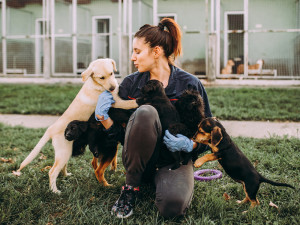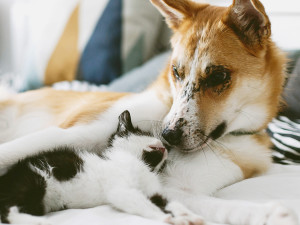Cons of getting a 2nd pet
Maybe you’re thinking about adding a second pet to your family but like any good pet parent, you’re doing some due diligence. Here are some considerations that might tip you into the column labeled, “don’t fix what isn’t broken."
1. Not everyone will get along.
As much as we try to blend dogs with dogs or cats with cats or a combo of both, some animals just don’t like each other. Like us, pets have preferences, and sometimes we don’t know what those preferences are until we try and realize our resident pet is less happy with the new kitten than being by herself. You can set everyone up for success by introducing them slowly over the course of weeks (not days) and by being deliberate about the kind of pet you think might work best. Adopting a young, exuberant puppy who will jump all over your arthritic, senior dog may not lead to the kind of bond you were hoping for.
Some of our favorite pet combos:
Pair a lazy, older pet with a similar cat or dog
A rambunctious adolescent dog or cat with a confident, older role model
A social butterfly with a slightly fearful pet to help them learn the ropes
An independent, picky pet with a goofy, won’t-take-things-too-seriously pet
2. It’s more expensive.
According to the 2021 American Pet Products Association’s survey, owners spend an average of $1,381 on their dog each year and $908 on their cat. While costs differ depending on the animal’s needs, you can expect to spend double on veterinary costs (vaccines, preventative care, emergency care, etc.), food, grooming, boarding and pet sitting, training, and toys.
3. Two pets may take twice the time to care for.
While some pet chores can be done as quickly with one pet as two, consider how you’ll exercise a second dog. Will two be too much to walk together, and you’ll need to schedule separate outings? What if they don’t play together and rely on you for playtime? Even if two pets love to wrestle or chase, it’s still important to spend one on one time with each in order to maintain a strong bond.
How much do you spend on your pet per year?
4. It won’t be as easy to travel, move, or transition your life.
While it might be simple to pack up your Labrador’s things and hit the beach for the weekend, it’s less easy with two dogs. With three dogs in my pack, I rotate their outings — the tiny one joined me on a ten-day road trip to see family this summer because she’s the easiest to bring to new houses and doesn’t take up much room in the car, while one of the Bigs came along on a beach vacation. The third dog is an excellent “conference” dog, nuzzling up to attendees and napping through sessions, so she joins me anytime I’m presenting or attending a conference.
Remember each pet has their preferences and strengths. Having more than one means fulfilling their individual needs.
If you’re a renter, it gets exceedingly difficult to find a pet-friendly option when you have more than one pet. If you anticipate needing to move in the near future, it may be worth holding off until you’re in a new place and then asking if you can add another pet. If you’re single and looking to start a relationship with someone, consider that they may have a pet of their own (we can only hope!) and it may be easier to introduce only one pet to their crew.
5. It might change the bond you have with your current pet.
Are there any oldest children out there? Remember when you had all your parents’ attention and then they brought home your sibling? It’s not much different for our pets. Things will likely change, particularly in the first few months when you’re getting to know the new pet, taking him to training class, or spending extra time playing with the new kitten. Be sure to schedule in one-on-one time with your resident pet in the short and long-term to help ease them through the transition.
Adding a 2nd (or 3rd or 4th…) pet can be an awesome experience but, it can also come with challenges. Make a plan, be deliberate, and ask your local shelter for help in match making and you’ll be well on your way to filling your home with an extended pet family.



